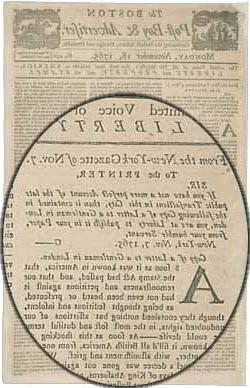"From the New-York Gazette of Nov. 7. To the Printer ..."
To order an image, navigate to the full
display and click "request this image"
on the blue toolbar.
-
Choose an alternate description of this item written for these projects:
- Main description
[ This description is from the project: Coming of the American Revolution ]
This letter to London describes the reaction to the arrival, in New York, of a "parcel of the stamps, which immediately raised a spirit of general uneasiness". The anonymous author reports on the hanging of an effigy in the likeness of Andrew Oliver, and the convening of "upwards of two hundred merchants" as well as shopkeepers, all agreeing to boycott British goods "till the stamp act was repeal'd."
The Art of Persuasion
Paraded through the streets of Newport, Charleston, Boston, and elsewhere, tortured effigies convince terrified stamp masters to resign their commissions. Meanwhile, however, the stamps are arriving at colonial ports. With no one to receive them, what is to be done with them? It is a question that occupies everyone, no matter his or her station in life or political point of view. The situation is especially tense in New York, where General Thomas Gage, commander-in-chief of British forces in North America, is headquartered. The Governor's Council has withdrawn to the shelter of Fort George, and the stamps have also been deposited there for safekeeping. Lieutenant Governor Cadwallader Colden and regimental officer Major Thomas James have been particularly uncompromising on the matter of the stamps, and Archibald Kennedy, captain of the HMS Coventry patrolling New York Harbor, stands ready, they assume, to do his part. New Yorkers, however, have learned the art of persuasion from their "cousins" to the north. Moreover, their merchants and shopkeepers are conspiring to stymie trade with the motherland.
To examine all four pages of this newspaper, please see the online display of The Boston Post-Boy & Advertiser, 18 November 1765.
Questions to Consider
1. What have the merchants of New York agreed to do? Be specific. Do you think their agreement will have an effect? Why or why not? What support will they expect?
2. Trace the progress of the stamps from their arrival in New York on 23 October 1765. Who has won the battle of the stamps? Explain.
Further Exploration
3. Compare the riot in New York to the earlier one in Boston in which Andrew Oliver was hanged in effigy. What is similar between the two events? What is different? Which event do you believe had the largest impact? Defend your answer.
4. Violence and the threat of violence are important factors in resisting the Stamp Act. Reflect on the mob actions in Boston and New York. Do you think those responses were appropriate? Why or why not? Defend your point of view. Are there any instances in contemporary American life in which you think such mob action would be justified? Explain.

